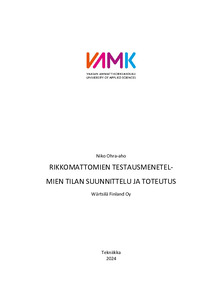Rikkomattomien testausmenetelmien tilan suunnittelu ja toteutus
Ohra-aho, Niko (2024)
Ohra-aho, Niko
2024
All rights reserved. This publication is copyrighted. You may download, display and print it for Your own personal use. Commercial use is prohibited.
Julkaisun pysyvä osoite on
https://urn.fi/URN:NBN:fi:amk-202405028654
https://urn.fi/URN:NBN:fi:amk-202405028654
Tiivistelmä
Tämän opinnäytetyön tarkoituksena oli suunnitella Wärtsilä Finland Oy:n Vaasan toimipaikan tutkimuslaboratorioon rikkomattomien testausmenetelmien tila ja luoda suunnitelmien pohjalta toteutussuunnitelma. Kohdetila, johon opinnäytetyö sijoittuu, sijaitsee tutkimuslaboratorion tiloissa. Tavoitteena on vastata puutteelliseen kykyyn toteuttaa omissa laboratorion tiloissa rikkomattomia testausmenetelmiä raskaille komponenteille siististi, turvallisesti ja ympäristöystävällisesti.
Opinnäytetyössä käsitellään yleisimpiä rikkomattomia testausmenetelmiä teoriatasolla. Työssä perehdytään kohdetilan vaatimuksiin ja työkalusteiden sekä laitteiden määrityksiin, joihin suunnittelun on vastattava. Lisäksi opinnäytetyössä esitetään suunnittelun vaiheita ja sen lopputulokset. Työn aikana käytettiin kyseisestä kiinteistöstä vastaavan asiantuntijan konsultointiapua ja tutkimuslaboratorion omaa materiaalitieteiden kirjallisuuden kokoelmaa. Suunnitteluprosessin aikana haastateltiin tutkimuslaboratorion henkilökunnan ja tulevan tilan käyttäjien näkemyksiä tilasta ja sen vaatimuksista.
Suunnittelun lopputuloksena muodostui tilakokonaisuus, joka vastaa tutkimuslaboratorion ja tuotekehityksen materiaalitutkimuksen tarpeita. Rikkomattomia testausmenetelmiä pystytään toteuttamaan turvallisesti, siististi ja jätevesien ympäristöystävällisyys huomioiden. Suunnitellut parannukset täyttävät vaaditut määritykset, jotka olivat laadittu siten, että tilassa voidaan toteuttaa rikkomattomia testausmenetelmiä valtaosalle tutkimuksiin saapuvista komponenteista. The purpose of this thesis was to design a room for non-destructive testing methods for the Vaasa investigation laboratory of Wärtsilä Finland Oy and create an implementation plan based on these designs. The target room is within the investigation laboratory premises. The objective was to respond to the inadequate ability to implement non-destructive testing methods for heavy components in a clean, safe, and environmentally friendly manner within the laboratory’s facilities.
The thesis covers the most common non-destructive testing methods at a theoretical level. It delves into the requirements of the target room and the specifications of the equipment that the design must meet. Additionally, the thesis presents the stages of the design process and its outcomes. During the making of the thesis, the consulting help of the expert responsible for property in question and the investigation laboratory’s own collection of literature of material science was used. During the planning process the employees of the investigation laboratory were interviewed regarding the room and its requirements.
The result of the design is a room that meets the needs of the investigation laboratory and material research team of research and development. Non-destructive testing methods can be implemented safely, cleanly and considering the environmental friendliness of wastewater. The designed improvements meet the required specifications which were prepared in such a way that non-destructive testing methods can be implemented in the room for most of the components arriving for the investigation.
Opinnäytetyössä käsitellään yleisimpiä rikkomattomia testausmenetelmiä teoriatasolla. Työssä perehdytään kohdetilan vaatimuksiin ja työkalusteiden sekä laitteiden määrityksiin, joihin suunnittelun on vastattava. Lisäksi opinnäytetyössä esitetään suunnittelun vaiheita ja sen lopputulokset. Työn aikana käytettiin kyseisestä kiinteistöstä vastaavan asiantuntijan konsultointiapua ja tutkimuslaboratorion omaa materiaalitieteiden kirjallisuuden kokoelmaa. Suunnitteluprosessin aikana haastateltiin tutkimuslaboratorion henkilökunnan ja tulevan tilan käyttäjien näkemyksiä tilasta ja sen vaatimuksista.
Suunnittelun lopputuloksena muodostui tilakokonaisuus, joka vastaa tutkimuslaboratorion ja tuotekehityksen materiaalitutkimuksen tarpeita. Rikkomattomia testausmenetelmiä pystytään toteuttamaan turvallisesti, siististi ja jätevesien ympäristöystävällisyys huomioiden. Suunnitellut parannukset täyttävät vaaditut määritykset, jotka olivat laadittu siten, että tilassa voidaan toteuttaa rikkomattomia testausmenetelmiä valtaosalle tutkimuksiin saapuvista komponenteista.
The thesis covers the most common non-destructive testing methods at a theoretical level. It delves into the requirements of the target room and the specifications of the equipment that the design must meet. Additionally, the thesis presents the stages of the design process and its outcomes. During the making of the thesis, the consulting help of the expert responsible for property in question and the investigation laboratory’s own collection of literature of material science was used. During the planning process the employees of the investigation laboratory were interviewed regarding the room and its requirements.
The result of the design is a room that meets the needs of the investigation laboratory and material research team of research and development. Non-destructive testing methods can be implemented safely, cleanly and considering the environmental friendliness of wastewater. The designed improvements meet the required specifications which were prepared in such a way that non-destructive testing methods can be implemented in the room for most of the components arriving for the investigation.
